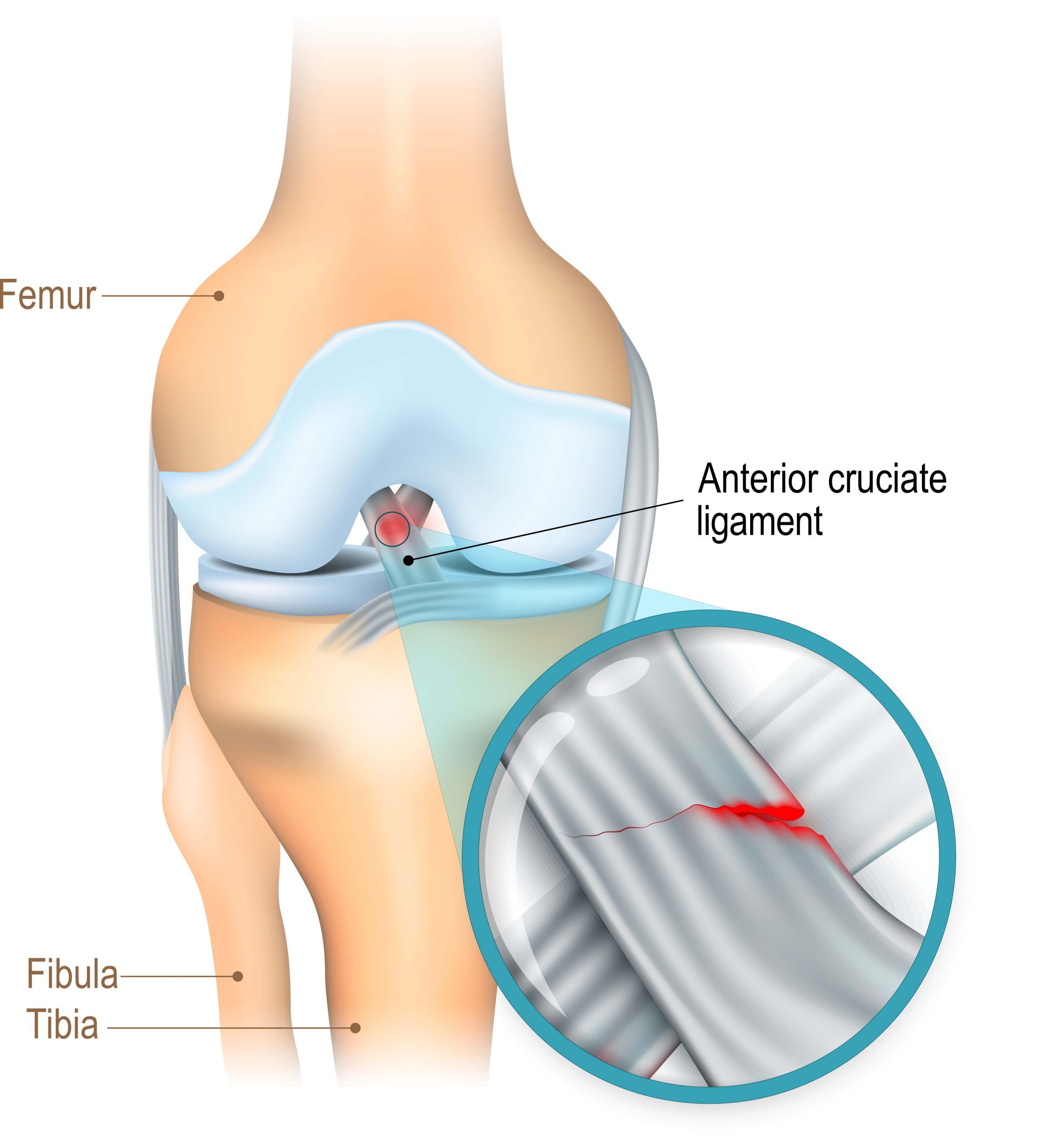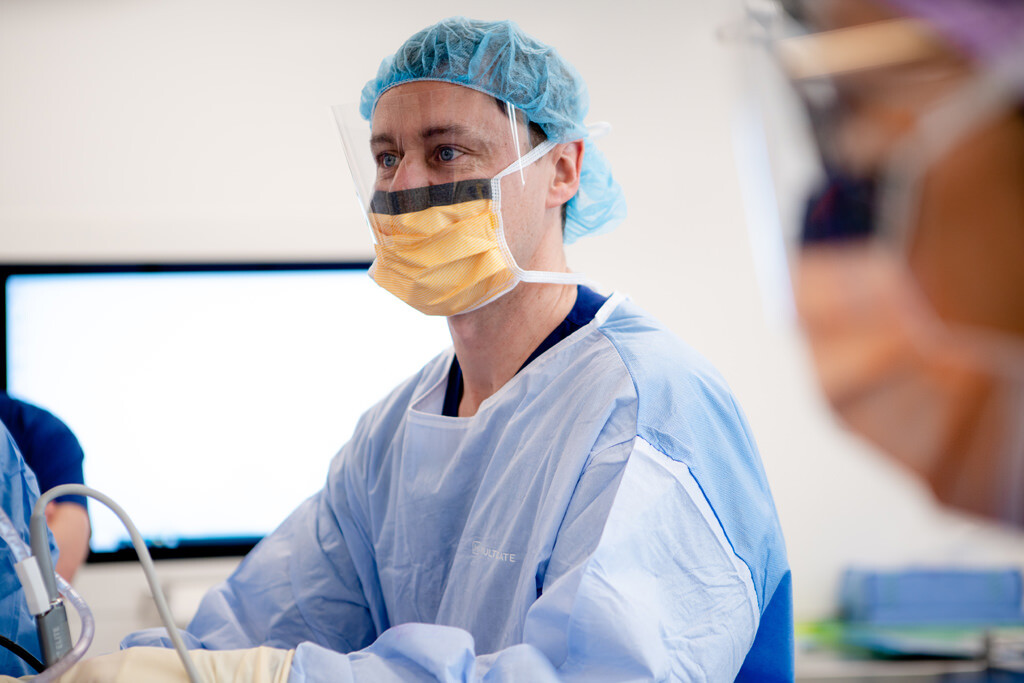Ligament joint injuries and ACL reconstruction
The anterior cruciate ligament (ACL) is one of the most common in the body to be injured. Serving to stabilise the knee joint, it connects the thighbone (femur) to the shinbone (tibia).
Roughly 75% of ACL ruptures happen with minimal or no contact at the time of injury, and 70% of patients feel or hear a popping sound as it occurs.

Treatment, signs, & symptoms of an ACL rupture
Ligament joint injuries in the knee typically present with severe pain and rapid swelling, often accompanied by a loud ‘popping’ sound or sensation at the time of injury.
The knee then feels quite weak and unstable, being unable to bear weight or giving way on attempts to walk.
Knee ligament injury treatment
Immediate treatment for ligament joint injuries involves elevating and resting the injured limb. Ice packs and over-the-counter non-steroidal anti-inflammatory drugs (NSAIDs) can assist in pain management and relieve swelling. Prompt assessment by a medical professional is essential in determining further treatment.
If a small tear is present to the ACL, ongoing conservative management and physiotherapy may be sufficient. As the ACL tendon does not heal or regrow on its own, reconstructive surgery is generally required to manage large ruptures.
What to expect during ACL reconstruction surgery
ACL reconstruction involves replacing the torn ligament with a graft from another source.
This is usually taken from your own body – a hamstring graft is most commonly used. Other donor sites may be quadriceps or patella tendon.
The orthopaedic surgeon then drills a small hole in the upper and lower leg bones. The replacement ligament is threaded through the opening and secured in place using endo button fixation or bone screws. This is performed arthroscopically.
Over 50% of all ACL ruptures have an associated injury to the meniscus, which may require a varied or separate surgery to effectively treat. Learn more about meniscal injuries and repairs by following the link.

Indications for ACL reconstruction
The need for surgery is typically based on the patient’s lifestyle and extent of injury. As the ACL serves to stabilise the knee, patients who are not physically active and do not require a high degree of knee stability may not require reconstruction.
These cases are often best managed through ACL tear physiotherapy to strengthen the knee joint and long-term activity modification (avoiding sports and heavy lifting).
ACL reconstruction is almost always required in the case of ACL injury with symptomatic instability, as the ligament cannot reattach itself.
In cases where a section of bone has detached alongside the ligament (avulsion fracture) or the ACL has torn from its attachment, the ACL may be repaired instead of reconstructed.
Recovery from ACL reconstruction
Immobilisation of the knee is usually not required following an ACL reconstruction. You will be allowed to stand as soon as you feel able, aided by crutches or another walking aid. Most patients are confident in walking without crutches a few weeks post-procedure.
Physiotherapy will guide your post op rehabilitation. Most patients can return to sporting activity at around 12 months.
Driving after an ACL reconstruction is not recommended until the patient does not require narcotic painkillers and can safely perform an emergency stop. This is typically 4-6 weeks following the procedure; orthopaedic surgeon Dr Jonathan Cabot will provide specific advice prior to your procedure. Bear in mind that some insurance providers have other requirements and these should also be considered.
Frequently Asked Questions
Common ACL rupture symptoms include:
- A loud pop sound at the time of injury
- Severe pain and inability to continue activity, especially in sports
- Rapid swelling within a few hours after the injury
- Loss of range of motion in the knee
- Instability or a “giving way” sensation in the knee, particularly when putting weight on it or trying to pivot
Diagnosis:
- Physical Examination: Dr Cabot may perform specific tests like the Lachman test, pivot shift test, or anterior drawers test to assess knee stability.
- Imaging: An MRI is typically used to confirm the diagnosis by providing detailed images of the ACL and other knee structures.
- X-rays: These may be used to rule out bone fractures, though they don’t show soft tissue like the ACL.
Treatment:
- Non-surgical: For partial tears or low-demand patients (e.g., sedentary lifestyle), treatment may involve rest, physical therapy, and possibly bracing.
- Surgical: Complete tears in active patients or athletes usually require ACL reconstruction surgery, where the torn ligament is replaced with a graft.
ACL reconstruction surgery is generally necessary when:
- The ACL is completely torn, especially in active patients who engage in sports or physically demanding activities.
- There is significant knee instability that affects daily activities.
- There are associated injuries, such as meniscal tears or damage to other knee ligaments.
- Non-surgical treatment does not relieve symptoms or restore knee stability.
The different graft options for ACL reconstruction include:
- Autografts: Tissue taken from the patient’s own body, typically from the patellar tendon, hamstring tendon, or quadriceps tendon.
- Allografts: Tissue from a deceased donor (cadaver), often used for patients who are older or prefer not to have tissue taken from their own body.
- Synthetic Grafts: Less commonly used, these are artificial materials designed to replace the ACL, often reserved for specific cases.
The exact ACL surgery recovery time varies depending on the patient’s age, physical condition, the type of graft used, and adherence to rehabilitation protocols. It usually takes: 2-3 weeks for basic recovery, with patients being able to walk with crutches; 3-6 months for moderate activities, such as running and agility exercises; and 6-9 months to return to sports or high-impact activities, though it can sometimes take up to 12 months.
Partial tears may heal with non-surgical treatments like physical therapy, bracing, and activity modification. Complete tears, however, typically do not heal on their own and often require surgical intervention for active patients or those experiencing knee instability. However, some low-demand individuals may manage with physical therapy alone if they can tolerate the instability and are not involved in high-demand sports.
For those experiencing an ACL injury and in need of an ACL reconstruction surgery should contact Dr Jonathan Cabot, experienced Adelaide orthopaedic surgeon and knee specialist, for compassionate and personalised care.